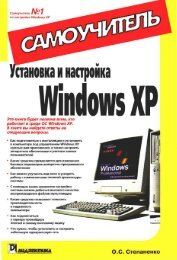You also want an ePaper? Increase the reach of your titles
YUMPU automatically turns print PDFs into web optimized ePapers that Google loves.
TECH<br />
PC GEEKS ARE SPLIT INTO THE RED<br />
Camp (ATI) and the Green Camp (Nvidia), > each staunchly defending their choices in<br />
graphics cards. For now, Nvidia’s latest graphics<br />
juggernaut, the GeForce 7800 GTX, is king of the<br />
hill when it comes to raw power. But at a cost of<br />
around 600 bones, all the pixel shaders in the world<br />
can’t save it from being an expensive add-on.<br />
BY THE NUMBERS<br />
Nvidia is quick to point out that the 7800 GTX architecture<br />
isn’t a simple product refresh or tweak of<br />
the GeForce 6800 Ultra—the vertex and pixel shader<br />
pipelines have been completely redesigned. But,<br />
since the core feature set is pretty much the same<br />
and the only differences are performance characteristics<br />
and power utilization, it’s easiest to understand<br />
the new architecture in comparison to the<br />
previous one. The 7800 has only 10 percent more<br />
memory bandwidth and the same pixel fill rate, and<br />
78 > COMPUTER GAMING WORLD<br />
MANUFACTURER: Nvidia<br />
PRODUCT: GeForce 7800 GTX<br />
Videocard<br />
runs at a mere 5MHz higher clock speed. The interesting<br />
parts are the 50 percent increase in pixel<br />
shader pipelines, from 16 to 24, and the 33 percent<br />
increase in vertex shader units.<br />
With just 10 percent more memory bandwidth,<br />
how does this GPU hope to be significantly faster<br />
than the 6800’s NV40 architecture? Nearly every<br />
part of the graphics pipeline has been tweaked,<br />
redesigned, or overhauled for greater efficiency.<br />
The 7800 GTX card draws about 100 watts, compared<br />
to 110 for the 6800 Ultra. Better still, the reference<br />
cooling solution is single slot and runs much<br />
more quietly—no leaf blowers here, which is great<br />
news for those building high-performance systems<br />
into smaller cases.<br />
FUN WITH BUZZWORDS<br />
One of the 7800 GTX’s big bullet points is what<br />
Nvidia calls Transparency Adaptive Anti-Aliasing filtering.<br />
TAAA is aimed at improving the image quality<br />
of textures with alpha (transparency) data.<br />
Current anti-aliasing methods smooth out most<br />
onscreen jaggies, but they can’t handle objects like<br />
chain-link fences that have “clear” spots where<br />
you’re supposed to see between the links. Nvidia’s<br />
new solution provides anti-aliasing to the links of<br />
those chain-link fences (or any other object with<br />
transparency in the textures).<br />
However, we should point out that the 7800 GTX<br />
doesn’t really do anything new to improve standard<br />
anti-aliasing modes. The cards are still limited to 4x<br />
multisample AA, plus the 8xS mode, which combines<br />
4x multisampling AA with 2x supersampling.<br />
The multisample pattern hasn’t changed at all—it’s<br />
still the tried-and-true rotated grid pattern used in<br />
the last generation of GeForce cards. Nvidia<br />
promises a boost to 16x AA, which will be a combination<br />
of 4x supersampling and 4x multisampling,<br />
> It’s<br />
I<br />
king of the hill<br />
when it comes to<br />
raw power.<br />
but it’s not in the initial driver release. The company<br />
promises a driver update soon that will enable this<br />
new mode, possibly only on SLI systems.<br />
Basically, the main goal of the 7800 GTX is greatly<br />
improved performance. This new architecture is all<br />
about making existing and upcoming games run<br />
much faster, especially those that use floating point<br />
textures and HDR rendering, like those using Unreal<br />
Engine 3.<br />
THE TEST RUN<br />
So how did the 7800 GTX stand up against the<br />
current crop of games? Maybe it was because we<br />
had a fully loaded Athlon 64 FX-55 (2x512MB<br />
DDR400 RAM and ASUS A8N-SLI Deluxe<br />
NUCLEAR POWER<br />
Nvidia GeForce 7800 GTX, brought to you by<br />
Making Sense of 3DMark05<br />
3DMark05 is the quintessential synthetic benchmark<br />
for testing gaming hardware. It’s primarily a<br />
graphics-focused test suite that utilizes DirectX<br />
9.0cwith Pixel Shaders 2 game tests, and features,<br />
batch, and CPU tests. The final score<br />
reflects a combination of graphics and CPU loads<br />
at 1280x1024 resolution with 2x antialiasing and<br />
4x aniostropic-filtering enabled.<br />
3DMark05<br />
WORST<br />
1,904<br />
�<br />
GeForce 7800 GTX<br />
NEW<br />
BEST!<br />
7,678<br />
HOW OUR GRAPH WORKS We graph a<br />
product’s benchmark scores to demonstrate<br />
how it compares to the scores of other products<br />
we’ve reviewed in the last six months. During<br />
that time, the lowest 3DMark05 Pro score we’ve<br />
seen is 1,904; the highest was 7,275, until now.<br />
�<br />
BENJAMINS<br />
ALERT<br />
As of press time, the 7800<br />
GTX is the fastest card<br />
on the market.<br />
Time to smash open<br />
the piggy bank!<br />
motherboard), but the 7800—as expected—cut a<br />
bloody path through our tests. The 7800 GTX has 50<br />
percent more pixel shader pipelines and a third more<br />
vertex shader pipes, so it’s unsurprising that its<br />
scores in 3DMark05 scores are roughly 50 percent<br />
higher than the 6800’s. And this is with 1600x1200<br />
resolution, as well as 4xAA and 8xAF turned on. It<br />
goes without saying: The new GPU also outstrips<br />
ATI’s best by quite a margin.<br />
As for real game tests: It’s hard to believe, but it’s<br />
Far Cry—not Doom 3 or Half-Life 2—that shows we<br />
still have plenty of need for more powerful graphics<br />
cards. A single 7800 GTX is about 25 percent faster<br />
than the 6800 Ultra, and 15 to 20 percent faster than<br />
the X850 XT PE. Is that enough to make the game<br />
CPU bound? Hardly. Two 7800 GTX cards in SLI<br />
show there’s still plenty of headroom left, so long as<br />
you run at a render state higher than 1280x1024<br />
without AA or AF.<br />
Bottom line, Nvidia has unquestionably produced<br />
the fastest videocard to date—at least until we see<br />
what the big deal is with ATI’s upcoming next-generation<br />
architecture, code-named R520. Unfortunately,<br />
this unprecedented speed comes with an unprecedented<br />
price tag: GeForce 7800 GTX cards are<br />
expected to cost $599. With GeForce 6800 Ultra<br />
cards selling for under $500 now, we can’t really say<br />
that the 7800 GTX represents much of an improvement<br />
in value. Basically, only three types of people<br />
will own these cards: the rich, the hardest of hardcore<br />
gamers, and tech editors. But if you’ve got the<br />
green and you want to run at high resolutions with<br />
anti-aliasing and anisotropic filtering all the time, it’s<br />
worth a look. /Jason Cross<br />
GeForce 7800 GTX $600<br />
Nvidia focuses on speed and delivers<br />
it in spades, but at a price that means<br />
many gamers won’t be able to enjoy it.<br />
VERDICT






